Author Janet Steele, who spent weeks in Malaysiakini office in Bangsar Utama last year, finds out what makes journalists in this online daily tick. This is her third of a five-part series.
In his landmark study of American news, sociologist Herbert Gans suggested that although the majority of journalists tend to be suspicious of ideology, they themselves subscribe to an ideology of objectivity, or the conscious practice of "value exclusion".
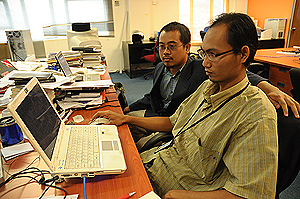 Although journalists at
Malaysiakini
differ from their American counterparts in that they are more explicitly motivated by a desire to bring about change, they share a similar sense of professionalism, non-partisanship, and understanding of what it is that makes
Malaysiakini
"independent".
Although journalists at
Malaysiakini
differ from their American counterparts in that they are more explicitly motivated by a desire to bring about change, they share a similar sense of professionalism, non-partisanship, and understanding of what it is that makes
Malaysiakini
"independent".
Former Singaporean journalist and media scholar Cherian George has called the kind of journalism practiced at Malaysiakini "contentious". A subset of alternative media, Internet news outlets in Singapore and Malaysia are:
"...contentious in that they directly and explicitly challenge the authority of elites in setting the national agenda and in forging consensus... These websites are engaged in more than just a struggle against government domination. They also embody competing normative notions of journalism and its role in democracy [and] subscribe to a more morally-engaged and less disinterested mode of journalism than their mainstream counterparts."
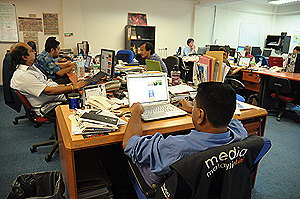 Despite this moral engagement, the journalistic values that are most prized at
Malaysiakini
are accuracy, independence, and balance.
Despite this moral engagement, the journalistic values that are most prized at
Malaysiakini
are accuracy, independence, and balance.
As K Kabilan, Malaysiakini's soft-spoken number two editor puts it, "we want to be different from the rest. We want to be responsible, show credibility. No spin for anyone."
Although I have never heard a Malaysiakini reporter or editor use the word "objective," they frequently use the word "independent", by which they mean factual, non-partisan, and outside of government control. As Gan explains:
"The media landscape in Malaysia is highly politicised. After all, most of the mainstream media organisations are either directly owned or indirectly linked to ruling parties. At the other spectrum are newspapers produced by the opposition parties.
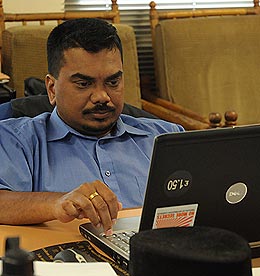 "Malaysians have not come across a truly independent media until
Malaysiakini
came into the picture. That is why the government has tried time and again to dismiss us as an opposition voice. Over the years, we have proven otherwise. This is something which the government does not know how to deal with."
"Malaysians have not come across a truly independent media until
Malaysiakini
came into the picture. That is why the government has tried time and again to dismiss us as an opposition voice. Over the years, we have proven otherwise. This is something which the government does not know how to deal with."
Kabilan ( left ) echoes Gan's understanding of independence as non-partisan, saying "when I tell a [journalist] that there is going to be a story on a Barisan Nasional person, and I know that the journalist has very strong personal views, I know that I can trust that [journalist] to do his or her job. I'm going to get balanced, fair copy. I can trust these journalists to do their jobs as professionals."
At Malaysiakini , independence also means applying the same critical standards to the opposition parties that they apply to the ruling coalition. In an election post-mortem meeting on March 19, 2008, Kabilan discussed the changing political landscape and warned reporters, "just as we are critical of Umno, be critical of the opposition. If we give credit to the opposition, also give credit to Umno."
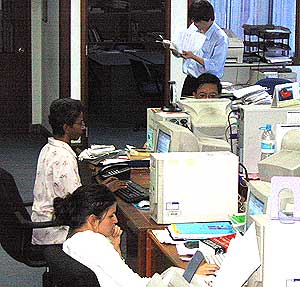 Padmaja Padman, another senior member of
Malaysiakini's
editorial team, echoed this concern, saying "now that we have promoted these people, we have to hold them accountable in the same way."
Padmaja Padman, another senior member of
Malaysiakini's
editorial team, echoed this concern, saying "now that we have promoted these people, we have to hold them accountable in the same way."
Much of Malaysiakini's understanding of doing what Gan calls "practicing good journalism" boils down to giving space to competing points of view and getting quotes from the "other side".
As Kabilan says, "we may not agree with you, but your space is there." Padmaja has a similar view, noting that during the election even Malaysiakini could have made more of an effort to push for the other side of the story. "If you're pulling down somebody, you must make the minimum attempt to get his response, and on the same day, or otherwise it may not happen, or it certainly won't get the same priority."
Taboo issues of race, religion
Although the "presentation of conflicting possibilities" is fundamental to what news people generally mean when they use the term objectivity, Malaysiakini's equation of independence with non-partisanship and "covering both sides" is rooted in the specifics of Malaysian political culture, in which the government has de facto control of the press, and laws prevent journalists from reporting on "sensitive" issues such ethnicity and religion that might result in ethnic disturbances.
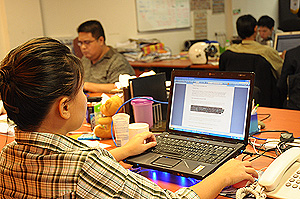 As Gan noted above, each of Malaysia's mainstream news organisations is either owned by or affiliated with a particular segment of the ruling coalition.
The Star
, for example, Malaysia's largest English-language daily, is owned by the MCA, a partner in the Barisan National.
As Gan noted above, each of Malaysia's mainstream news organisations is either owned by or affiliated with a particular segment of the ruling coalition.
The Star
, for example, Malaysia's largest English-language daily, is owned by the MCA, a partner in the Barisan National.
The New Straits Times Press group, which publishes both the English-language New Straits Times and two Malay broadsheets, Utusan Malaysia and Berita Harian , is owned by an Umno-linked company. Most of the Tamil papers are under the control of the MIC.
There is so much self-censorship in the mainstream press that journalists don't even bother to submit stories they know will get spiked. Nash Rahman, the editor of Malaysiakini's Malay language section, says that Malaysiakini is different in that "there is no self-censorship".
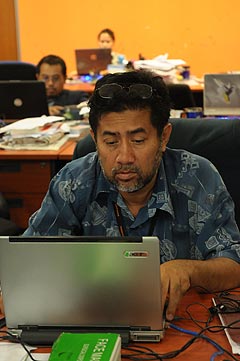 According to Nash (
right
), who was once chief news editor of
Berita Harian
, "in the mainstream media, reporters keep things to themselves because the editors will throw it away, or they will get scolded. Here they report on everything and the confidence level is high."
According to Nash (
right
), who was once chief news editor of
Berita Harian
, "in the mainstream media, reporters keep things to themselves because the editors will throw it away, or they will get scolded. Here they report on everything and the confidence level is high."
Malaysiakini's editorial desk has three news sections (English, Malay, and Chinese) and a Tamil section that to this point has been primarily responsible for translations. Yet despite the structural similarities to the organisation of the mainstream media, the way in which the sections interact is completely different.
Kabilan describes his experience at the New Straits Times as being camaraderie on the surface, but not deep down. "It's very different at Malaysiakini . I don't see grouping ethnically."
Bahasa Malaysia section editor Nash Rahman adds that at Malaysiakini interaction is based on trust, not on adhering to a partisan line.
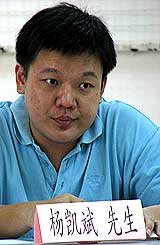 "
Malaysiakini
is very open," he says. "Steven trusts Kai Ping [the Chinese editor] (
left
), even though he cannot read Chinese. Steven could be in a position where he has to defend something that was published in the Chinese section - something that he might not be able to understand. That is trust."
"
Malaysiakini
is very open," he says. "Steven trusts Kai Ping [the Chinese editor] (
left
), even though he cannot read Chinese. Steven could be in a position where he has to defend something that was published in the Chinese section - something that he might not be able to understand. That is trust."
At the time of the March 2008 general elections, Malaysiakini's editorial desk consisted of 29 people. On the print side, there were nine editors and 12 journalists. In addition there were five video journalists and editors, a senior graphic designer and an online librarian.
The group is remarkably multiracial, with 13 Chinese (45%), 10 Malay (34%) and six Indian (21%). If we just consider those seven senior editors and producers who attend the daily editors meeting, the split is two Chinese, three Indians and two Malays.
The organisational structure of Malaysiakini is interesting for several reasons, including the way in which it can be seen as a conscious extension of Gan's and Chandran's student activism. Whereas Gan has always identified himself primarily a journalist, Chandran sees himself as an activist who uses journalism as a "vehicle for democracy".
"I look at things more practically," he says. "Now we have to go and prove it. Prove it! Prove it! Does it work? It was my physics-like model."
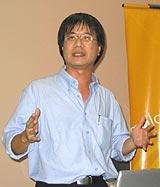 As a student, Gan (
right
) was a strong supporter of collectivism. "With Steven, it's kind of like a religious practice," Chandran says, "and
Malaysiakini
is his sphere. He did the same thing at
The Sun.
.. It's all in his personal sphere of influence. He never advocates it publicly; it's more of a self-belief."
As a student, Gan (
right
) was a strong supporter of collectivism. "With Steven, it's kind of like a religious practice," Chandran says, "and
Malaysiakini
is his sphere. He did the same thing at
The Sun.
.. It's all in his personal sphere of influence. He never advocates it publicly; it's more of a self-belief."
If part of Gan's unspoken belief system is that you change your world by changing your sphere, he has managed to implement much of this at Malaysiakini . It is a democratic, ethnically diverse organisation in which power is decentralised and people make decisions together. As Kabilan says, "everyone has a say, even with regard to the colour of the paint on the walls."
Thus what makes Malaysiakini different from other news organisations is not the diversity of the newsroom per se, but rather the collective effort to deal directly with "sensitive" issues such as ethnicity, race and religion, and to do so within an environment of mutual respect. When I asked Gan about race, he said,
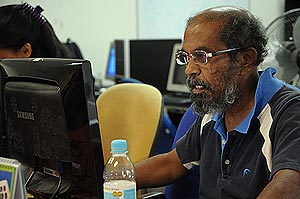 "I think it is very difficult for Malaysians to think outside their own ethnic identification... [It's apparent] when you fill out a form, in everything that you do. I know that people will argue that we shouldn't emphasise race in our reports, but if we try to report in a way that race doesn't matter, that is dishonest.
"I think it is very difficult for Malaysians to think outside their own ethnic identification... [It's apparent] when you fill out a form, in everything that you do. I know that people will argue that we shouldn't emphasise race in our reports, but if we try to report in a way that race doesn't matter, that is dishonest.
"Sometimes covering topics as controversial as the New Economic Policy (which gives economic privileges to ethnic Malays) or the issue of religious apostasy can make people at Malaysiakini feel uncomfortable."
Gan describes one young Malay reporter who at first said he didn't want to cover issues of Islam. Gan recalls having told him, "Look, you are a journalist. There is no way out. You have to do these stories. It's your job."
Tomorrow - Part 4: It's called 'watchdog' journalism
Part 1 l How Malaysiakini challenges authoritarianism
Part 2 l 'Our agenda is press freedom'
Part 3 l Holding the powers-that-be accountable
Part 4 l It's called 'watchdog' journalism
JANET STEELE is an associate professor of Journalism at the School of Media and Public Affairs at George Washington University. Her most recent book 'Wars Within' focuses on Tempo magazine and its relationship to the politics and culture of New Order Indonesia. She is a frequent visitor to Southeast Asia, and writes a weekly newspaper column called 'Email dari Amerika' for Surya daily in Surabaya, East Java.
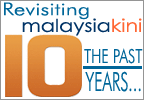 Malaysiakini
is celebrating its 10th year anniversary on Saturday, Nov 28 with a gala dinner at the Sime Darby Convention Centre in Bukit Kiara. Be there! Seats available from RM100.
Malaysiakini
is celebrating its 10th year anniversary on Saturday, Nov 28 with a gala dinner at the Sime Darby Convention Centre in Bukit Kiara. Be there! Seats available from RM100.
Click here for more information.

